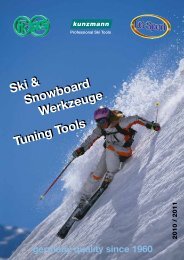ALPINE SKI & SNOWBOARD PREPARATION
ALPINE SKI & SNOWBOARD PREPARATION
ALPINE SKI & SNOWBOARD PREPARATION
You also want an ePaper? Increase the reach of your titles
YUMPU automatically turns print PDFs into web optimized ePapers that Google loves.
(the same thing also happens when you are in the<br />
halfpipe), try either of the following.<br />
First, choose 0.5 degree more beveling of the<br />
base-side of the edge or if this is not enough, use<br />
the Swix rubber stone Swix T992 or Swix T994 to<br />
gently dull the edge.Put the rubber stone on the<br />
edge and move it back and forth. A little bit at the<br />
time (5 cm). Up to 25 - 30 cm from the nose and<br />
backwards and up to 25-30 cm on the tail.<br />
TREATING SCRATCHES AND DAMAGED STEEL<br />
EDGES<br />
If an edge has hit a rock, this can temper the<br />
steel edge. These areas need to be removed with<br />
a stone such as the Swix T240 before you can<br />
continue with a file. If this is not done, the file<br />
will “skid” over the hardened area, resulting in a<br />
damaged file and uneven sharpening of the edge.<br />
Removing the damaged area is necessary and<br />
easy, using the Swix T240 stone. After removing<br />
the area with the Swix T240 stone, filing the edge<br />
can continue and it will be much easier. (See illustration<br />
#4 page 37.)<br />
Rider: Per Iver Grimsrud<br />
Photo: Carl Ostberg<br />
Courtesy of SnowboardForbundet (NOR)<br />
PREPARING EDGES ON <strong>ALPINE</strong> <strong>SKI</strong>S<br />
IN GENERAL<br />
The set-up of the edges depends upon the type<br />
of ski, properties of the ski, usage of the ski, the<br />
skiers technical skills and the skiers ability to feel<br />
the kind of snow he/she is skiing on. The set-up<br />
of the edges must be adapted to each individual<br />
skier. The best results will be achieved through<br />
testing and experiencing different snow conditions.<br />
Both edge on each ski has to be treated<br />
equally and can be adjusted later when the skis<br />
have been tested on snow. To make sure that the<br />
skis perform perfectly on snow and ice, the edge<br />
has to be even and polished without scratches or<br />
other damage.<br />
To ensure optimal gliding and ski-ability, the<br />
base-side edges has to be even with the base.<br />
The right tools are important and practical<br />
for a good result. Top quality vises like the Swix<br />
T149-50 is a good start, combined with other<br />
tools that will be mentioned later.<br />
Keeping your workplace and tools clean is<br />
essential for best results. Procedures and the use<br />
of different tools are described step by step from<br />
page 37.<br />
BASE-SIDE EDGES - <strong>PREPARATION</strong> AND FILING<br />
All racing skis today use beveled edges. This<br />
means that we give the base-side of the edge a<br />
certain fixed angle (see illustration page 9).<br />
By beveling the edges, we get the following<br />
benefits:<br />
• The edge has a slight angle to the surface and<br />
will carve more progressively.<br />
• The ski will be easier to turn and control.<br />
• Both edges of both skis will be less aggressive<br />
sideways towards the snow. The result will be less<br />
risk of catching an edge and losing control. This<br />
is very important, especially in speed events like<br />
Super-G and Downhill. In slalom, some racers prefer<br />
0 degree beveling. This means the ski will be<br />
precise and feel more aggressive. This demands a<br />
stronger and more technically skilled racer.<br />
Tools that are used for base-side preparation<br />
are Swix TA05, Swix TA075, Swix TA010 or Swix<br />
TA0515. (Read more about the tools on page 11.)<br />
PLANING AND PREPARING THE <strong>SKI</strong>S<br />
SIDEWALLS<br />
The sidewall of a ski normally has a thin plastic<br />
(sometimes aluminum) edge directly above the<br />
steel edge. This needs to be removed in order to<br />
do get the best results after filing on sidewall-side<br />
edges. By removing a small portion of this edge<br />
with a specialized planer, the risk of getting plastic<br />
in the file is reduced. This small plastic side-edge<br />
gives support to the steel edge and is important<br />
that it is removed gradually. There might be a thin<br />
sheet of metal above the steel edge on some skis.<br />
This is removed together with the plastic with<br />
the same tool. We recommend using a specially<br />
designed planer for this. The planer blade is either<br />
round or square. Swix TA100R (round) is normally<br />
used on skis with a cap construction, while the<br />
Swix TA100SB (square) is used on traditional<br />
sandwich constructions. Use the “panzer” file<br />
Swix T108 to get a smooth and even surface on<br />
the sidewall. To finish off, use the fine Swix T350<br />
silicone-carbide paper # 180 and Swix Fibertex<br />
T264. This work is done exclusively on the sidewalls<br />
and not on the steel edges. (See illustration<br />
page 39.)<br />
FILING AND PREPARING SIDEWALL-SIDE EDGES<br />
The sidewall-side of the steel edges are also beveled<br />
to give better grip on hard snow and ice. The<br />
sharper the angle between the sidewall-side and<br />
the base-side of the edge, the more “aggressive”<br />
the grip on the snow will be. This angle depends<br />
upon the following factors:<br />
The skis properties, the skill level of the skier,<br />
the skiing discipline (SL, GS, S-G or Downhill) and<br />
the type of snow. Kids and junior level skiers may<br />
use between 2 - 3 degrees, World Cup skiers up<br />
6 7





